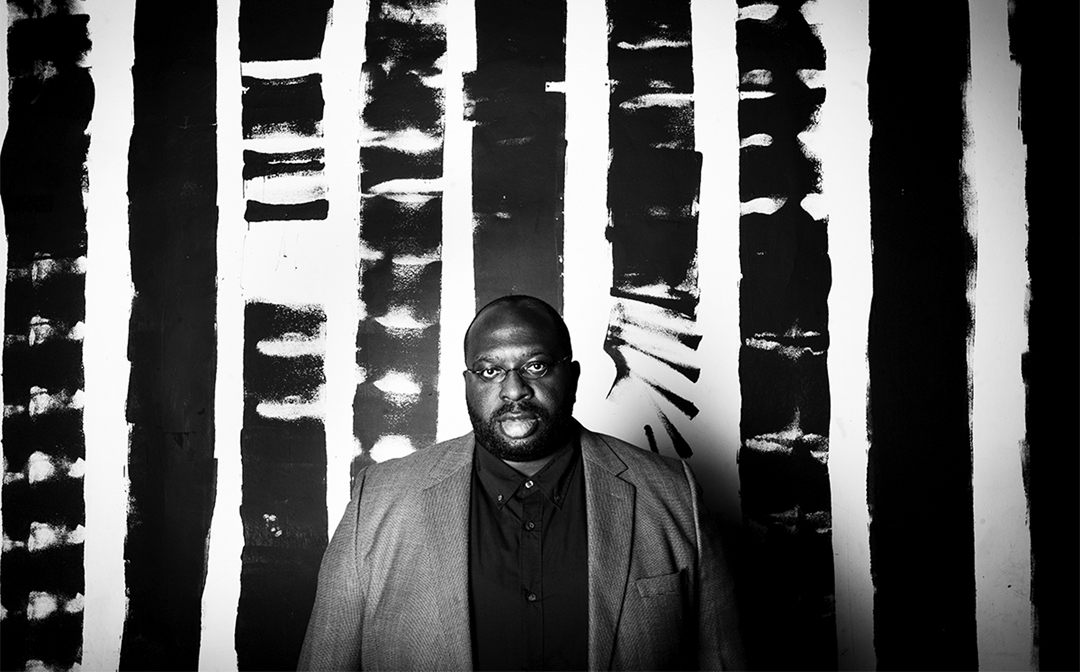
Darius Jones Photo by Kholood Eid
Tuesday, March 13, 8pm
Chapel Performance Space
4649 Sunnyside Ave N
Presented by Earshot Jazz
Upon arriving in New York in 2005 from Richmond, Virginia, alto saxophonist Darius Jones quickly established himself as an expansive force, a player with sufficient range, imagination, and expressiveness that he could credibly declare: “This is jazz, now.”
In some regards, however, his is a jazz where the term “jazz” is a bit beside the point. As the variety and range of his musical associations in and around New York attests, Jones is steeped in many streams of musical tradition, but bound by none.
Yes, he has schooled himself in the alto styles of innumerable jazz forebears. Johnny Hodges is among many noted—and, indeed, he cites Duke Ellington’s lyrical star sideman as “my favorite saxophonist of all time” for his command of vibrato, glissandos, and other techniques. Also audible in his playing are the likes of more overtly “free” innovators like Albert Ayler.
Jones has parsed out and recombined the technical and aesthetic DNA of the free-jazz stream, where novel sounds have been devoutly sought, and their demands on audiences rarely dodged. And yet he has said that he thinks of himself not so much as a “jazz musician,” but rather as a “soul musician.”
He means that in a particular sense. As he told All About Jazz in 2011: “I think it is important that music has the healing force or power, that music can touch you, that you can feel it.”
To that end, he has gathered up, into his craft, sounds of many kinds. Growing up in Richmond, he listened keenly, and widely, adapting whatever he heard to his own quest. From his southern childhood and youth, he has brought the passionate commitment of church worship, but also the worldly and inner struggles of the great blues innovators and the entertaining bluster of the juke joints, or their modern-day variants.
He also cites as inspirations the likes of vocalists Betty Carter, from jazz, and Patti LaBelle, from R&B, as well as Parliament and Funkadelic and hip-hopper Ol’ Dirty Bastard of Wu-Tang Clan. Many others, too, from many musical streams, with a particular embrace, he has said, of the “raw and beautiful, rough and black.”
The outcome of all that is that his playing can just as often be bluesy or swinging, playful or intense, whispering or howling, and much else. He lives out his soul musicianship broadly, with sometimes direct, sometimes oblique reference to jazz traditions. For example, again as he told All About Jazz in 2011, although he had embraced the spirit, techniques, and concepts of “free jazz,” he is not a “free jazz” player, with all the limitations that that categorization ironically entails. But nor, Jones said of himself, could he be located in the ranks of modern-day “standard” saxophonists; rather, he said, “there is a third category, and I’m about to show you what it is!”
He would do that with a guiding principle: “I want to be free. I want to create a universe that’s my universe.”
His grand project has come in multiple forms. His collaborations in and around New York have been varied and seemingly tireless. He has a working trio with bassist Adam Lane and drummer Jason Nazary. From early in his New York days, he has been in a “noise-jazz” quartet, Little Women, which includes another saxophonist of rising reputation, Travis Laplante (Battle Trance). He is a member of the smoldering collective quartet Grass Roots with drummer Chad Taylor, bassist Sean Conly, and baritone saxophonist Alex Harding; they released a powerful album, Grass Roots, in 2013. Then he has appeared from time to time with the likes of uncompromising drummer William Hooker, and the more readily accessible but edgy Mara Rosenbloom Quartet. His list of associations goes on: Eric Revis Quartet, Oliver Lake Big Band, William Parker Orchestra, Mike Pride’s From Bacteria to Boys, and more.
Jones has released two acclaimed albums of improvisations with one of the freshest—and, again, uncompromising—pianists of the day, Matthew Shipp.
Certainly the most striking component of Jones’ project, however, is his projected nine-disc Man’ish Boy series, now five discs in, on the New York label, AUM Fidelity, where Jones’ labelmates include the likes of Shipp, Parker, David S. Ware, Craig Taborn, and Joe Morris—heavyhitters, all.
Throughout his Man’ish Boy project, Jones has regarded jazz with both folk-ish homage-to-the-elders and futuristic slants that have won over many critics. Those hailed the first release as proof of a “singular artistry” in such terms as intensely soulful, hollering, keening, preaching, lush, propulsive, and fearless but disciplined. That enthusiasm has greeted all five of the releases in the series, to date.
After Man’ish Boy, in 2011, came Big Gurl (Smell My Dream) featuring the Darius Jones Trio with bassist Adam Lane and drummer Jason Nazary. In 2012, Book of Mæ’bul (Another Kind of Sunrise), followed; it saw Jones teaming with three more individualists, pianist Matt Mitchell, bassist Trevor Dunn, and drummer Ches Smith. The Oversoul Manual of 2014 was Jones’ suite for a four-voice “jazz classical chamber vocal ensemble,” The Elizabeth-Caroline Unit. And most recently, on Le Bébé de Brigitte (Lost in Translation) (2015), Jones augmented his quartet of Mitchell, Smith, and Conly with French vocalist Emilie Lesbros to create a bilingual album whose lyrics explore the struggles of human communication and evoke the Brigitte of the title. She is the blind and love-blind mother of D’Troy·t, a character whose wickedness Jones will evoke in the next installment of his Man’ish Boy project.
As all that suggests, the musical universe of Darius Jones is no rehearsal of received jazzisms.
–Peter Monaghan
Tickets for Darius Jones are $15 adult, $13 Earshot members and senior citizens, $10 students and military and are avaialble at earshot.org.